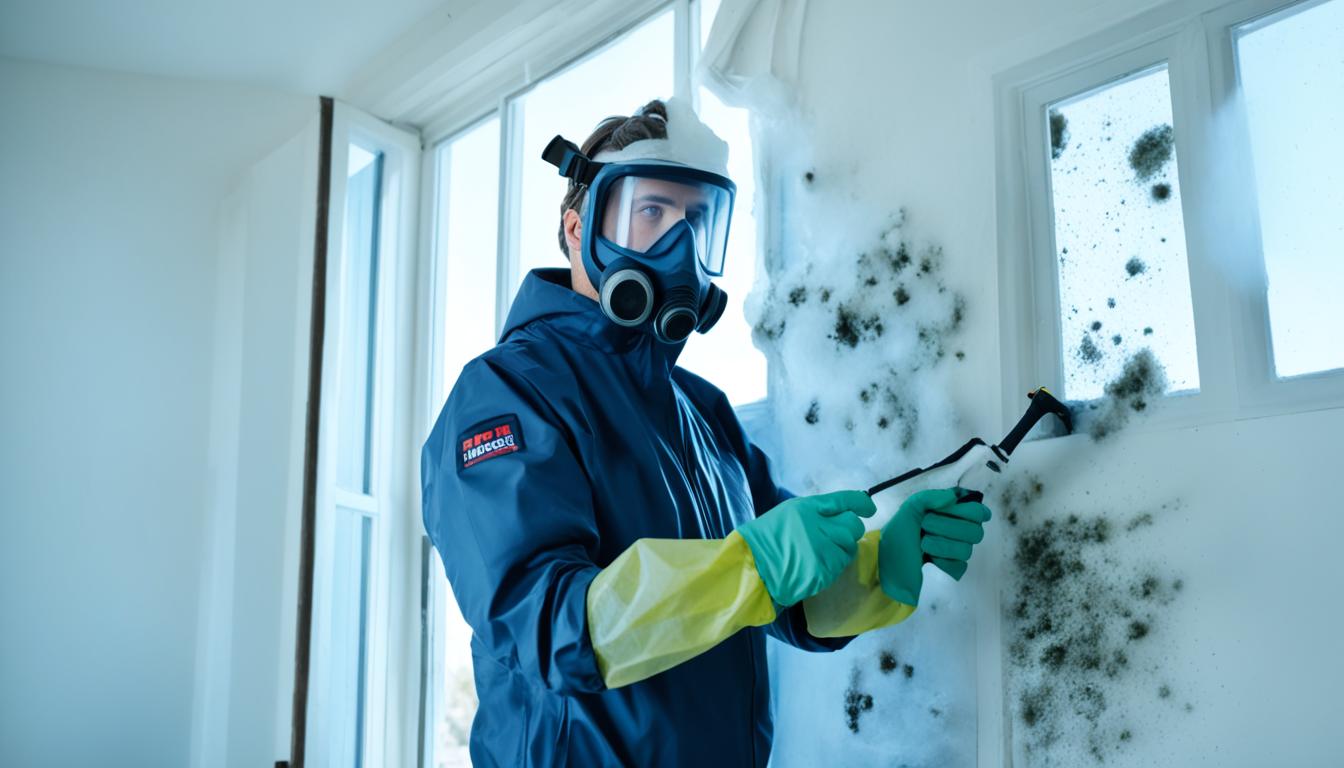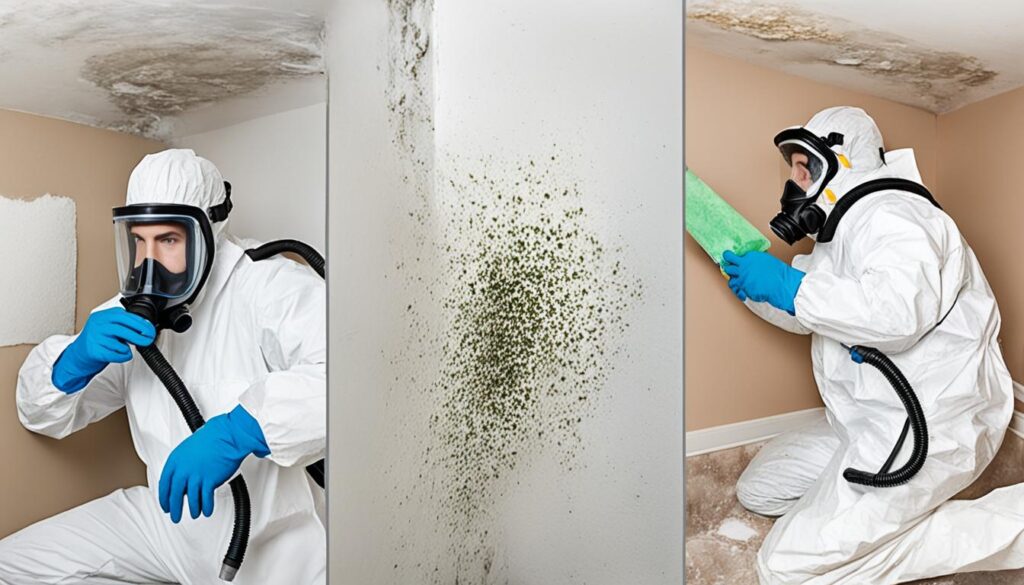
Mold Remediation Guide: Fixing Wall Mold Safely
Welcome to our comprehensive mold remediation guide, where we will provide you with expert techniques on how to effectively fix mold in walls. Dealing with mold can be a daunting task, but with the right knowledge and approach, you can ensure a safe and successful mold removal process.
Mold growth on walls is a common problem that can lead to serious health issues if left unaddressed. In this section, we will guide you through the proper mold removal techniques and share strategies to prevent future mold growth, keeping your home or office environment clean and healthy.
Key Takeaways:
- Learn effective techniques to fix mold in walls.
- Understand the importance of proper mold removal techniques.
- Discover strategies to prevent future mold growth.
- Ensure a safe and healthy living or working environment.
- Follow professional advice for successful mold remediation.
Now that we have covered the introduction, let’s delve into the different approaches to mold removal: DIY methods and professional mold remediation.
DIY Mold Removal and Professional Mold Remediation
When it comes to dealing with mold in your walls, you have two options: DIY mold removal or professional mold remediation. Both approaches have their pros and cons, so it’s important to understand the differences and choose the best path for your situation.
If you’re a DIY enthusiast or on a tight budget, DIY mold removal may be a viable option. This method involves tackling the mold problem yourself using readily available tools and products. However, it’s crucial to note that DIY mold removal is only recommended for small-scale mold issues and surface-level contamination.
To effectively remove mold on your own, follow these steps:
- Identify the source of moisture that is causing the mold growth.
- Wear protective gear, including gloves, goggles, and a mask, to limit your exposure to mold spores.
- Isolate the affected area to prevent the spread of mold spores to other parts of your home.
- Scrub the mold-infested surface using a mixture of water and detergent. For stubborn mold stains, consider using a mold-specific cleaner.
- Thoroughly dry the area after cleaning to prevent future mold growth.
- Monitor the area closely to ensure the mold does not return.
While DIY mold removal can be a cost-effective solution, it’s important to recognize its limitations. If the mold contamination is extensive, or if you are dealing with toxic black mold, it’s best to seek professional mold remediation services.
Professional mold remediation involves hiring trained experts who have the knowledge, experience, and specialized equipment to handle even the most severe mold problems. They follow strict protocols to ensure the safe and effective removal of mold from your walls.
Benefits of professional mold remediation include:
- Thorough inspection and identification of all mold sources.
- Advanced techniques and equipment for comprehensive mold removal.
- Proper containment measures to prevent cross-contamination.
- Effective treatment to address underlying moisture issues.
- Reduced risk of health hazards associated with mold exposure.
If you choose to hire professionals for mold remediation, make sure to do your research and select a reputable company with a proven track record. Remember to inquire about their certifications, warranties, and the specific methods they use for mold removal.
Wall Mold Treatment
Regardless of whether you opt for DIY mold removal or professional mold remediation, it’s essential to treat your walls properly to prevent future mold growth. After removing the mold, consider the following wall mold treatment steps:
- Address any underlying moisture issues, such as leaks or high humidity, to eliminate the conditions favorable for mold growth.
- Repair any damaged areas of your walls, such as cracks or gaps, to prevent moisture intrusion.
- Apply mold-resistant paint or sealant to the walls to create a barrier against future mold growth.
- Improve ventilation in the affected area to promote air circulation and reduce moisture buildup.
- Regularly inspect and maintain your walls to identify any signs of mold growth early on.
By following these wall mold treatment steps, you can significantly reduce the likelihood of mold reappearing in your home.
Best Mold Removal Products
Whether you choose to tackle mold removal yourself or hire professionals, having the right mold removal products is crucial for successful remediation. Here are some of the best mold removal products recommended by experts:
| Product | Description |
|---|---|
| Borax | A natural and eco-friendly mold killer that can effectively remove mold on various surfaces. |
| Hydrogen Peroxide | A non-toxic and versatile mold remover that can be used on different types of materials. |
| Vinegar | A common household item that has antimicrobial properties and can kill mold spores. |
| Mold Control Spray | A specialized mold control solution that effectively eliminates mold and prevents its regrowth. |
These are just a few examples of the best mold removal products available. When choosing a mold remover, consider factors such as the extent of the mold contamination, the type of surface being treated, and your personal preferences.

Dealing with Mold Stains and Removing Mold Spores
In this section, we will address effective techniques for dealing with stubborn mold stains and removing mold spores, ensuring a thorough mold remediation process. Mold stains can be unsightly and may indicate deeper mold infestations that need to be addressed promptly. Additionally, mold spores can cause allergic reactions and respiratory issues, making their elimination crucial for a healthy living environment.
If you notice mold stains on walls or other surfaces, it’s important to tackle them as soon as possible to prevent further damage. Here are some steps you can follow to deal with mold stains:
- Assess the extent of the mold stain: Carefully examine the affected area to determine the size and severity of the mold stain. This will help you determine the appropriate approach for removal.
- Prepare a cleaning solution: Depending on the surface and the severity of the stain, you can create a mixture of vinegar and water or use a commercial mold stain remover. Follow the product instructions for the best results.
- Apply the cleaning solution: Use a sponge or cloth to apply the cleaning solution to the mold stain. Gently scrub the area in a circular motion, focusing on removing the stains without spreading the mold spores.
- Rinse and dry: After removing the mold stain, rinse the area with clean water and dry it thoroughly. Ensure that the surface is completely dry to prevent mold regrowth.
- Monitor for mold regrowth: Keep an eye on the treated area to ensure the mold stain doesn’t reappear. If you notice any signs of regrowth, it may indicate a deeper mold problem that requires professional assistance.
In addition to cleaning mold stains, it’s crucial to eliminate mold spores to prevent future mold growth. Mold spores are microscopic and can easily spread through the air, leading to new mold colonies. Here are some strategies to remove mold spores:
- Improve ventilation: Increase airflow in your home by opening windows, running exhaust fans, and using dehumidifiers. Proper ventilation helps reduce moisture levels and discourages mold spore growth.
- Clean and dust regularly: Regularly clean surfaces and remove dust, as mold spores can settle on household items and contribute to indoor mold growth.
- Use air purifiers: Consider using air purifiers with HEPA filters to capture and trap mold spores in the air.
- Address underlying moisture issues: Mold thrives in damp environments, so it’s essential to identify and fix any leaks or moisture problems in your home. Repairing water damage and maintaining proper humidity levels will help prevent mold spore proliferation.
By effectively dealing with mold stains and removing mold spores, you can ensure a thorough mold remediation process and create a clean and healthy living environment. Remember, if you encounter extensive mold issues or require professional assistance, it’s best to consult with a reputable mold remediation company like Fix Mold Miami.

Conclusion
In conclusion, we have provided you with a comprehensive mold remediation guide, offering expert techniques for fixing mold in walls. By following the steps outlined in this guide, you can safely remove mold, prevent its future growth, and create a clean and healthy environment.
Firstly, it is important to address mold growth promptly to avoid potential health risks and structural damage. Our guide has equipped you with the knowledge and tools to tackle mold-related issues effectively.
Remember, prevention is key to maintaining a mold-free home. Regular inspections, proper ventilation, and controlling moisture levels are essential in preventing mold growth. Should you require professional assistance, contact Fix Mold Miami at 305-465-6653 for a mold assessment. Their team of experts is equipped to handle all your mold remediation needs.




